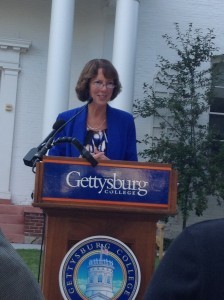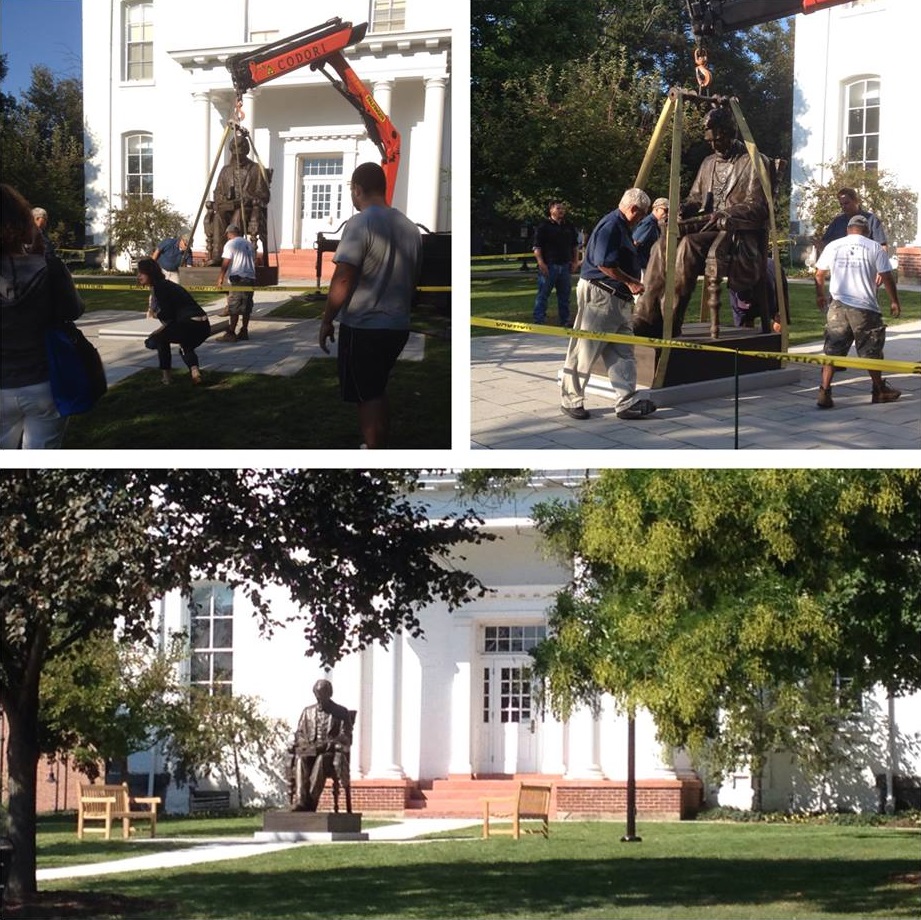By Julia Sippel, Staff Writer
As summer came to a close, many students were perplexed by the construction beside Stevens Hall, built in 1868 and named after abolitionist Thaddeus Stevens.
On Friday, Sept. 18 this confusion was resolved by the appearance of a large bronze statue of President Abraham Lincoln, by no means a newcomer to Gettysburg. Built by artist Stan Watts (the same sculptor who brought Lincoln to life outside of the public library), this new acknowledgement of Abe is sure to become a favorite on campus.
The statue’s dedication was a unifying occasion for the College community, bringing alumni and trustees from afar to join in the gaiety.
The celebration began with a formal luncheon and discussion panel in the College Union Building Ballroom, complete with a catered meal and the awe-inspiring company of some of the College’s most notable alumni. Professor Michael Birkner led the Civil War Institute’s Dr. Peter Carmichael and Dr. Jill Ogline Titus, as well as History and Africana Studies professor Scott Hancock, in a discussion of the Emancipation Proclamation both then– it was formally issued on January 1, 1863– and now.
Perhaps most notably, it was here that the parallel began between the “then,” referring to the Civil Rights Movement, and today’s racial discussion (or lack thereof).
On the disillusionment behind Lincoln as “The Great Emancipator,” Dr. Carmichael described the political situation upon the Proclamation’s issuance. With Lincoln’s policy of “hav[ing] no policy,” his goals were simply to win the war and reconcile the union. It “rarely spawned general concern for African Americans,” he surmised. Liberty and Union were central to the moral vision of Union, not emancipation.
Dr. Hancock elaborated, drawing upon W.E.B. DeBois’ thoughts and metaphor of a veil separating African Americans “deeply and profoundly” from the white counterparts. “No man can give anyone his freedom,” he said, quoting Civil Rights activist Stokely Carmichael.
The panelists and guests who spoke up in the interactive period of the discussion were in agreement that the work of the Emancipation Proclamation is far from over.

Bruce Gordon ’68 speaks about the continuing need for equality at the statue’s dedication. Photo courtesy of Julia Sippel.
This discussion continued at the afternoon’s dedication as the sun shone adjacent to Stevens Hall. After an introduction by Board of Trustees Chair James L. Chemel (’71), Dr. Jill Titus came to the microphone once more. Again, she explained the importance of using “our Civil War past to talk about our present.”
Dr. Titus was followed by Trustee Emeritus and Former Chair of the National Association for the Advancement of Colored People (NAACP) Bruce Gordon (’68). “Our nation has been on a journey,” he said, “…my people have been on a journey.” The struggle for freedom and equality is far from over.
Gordon remembered being a first year at Gettysburg when the Civil Rights Act of 1964 was signed, when the great-grandchildren of those “freed” by the Emancipation Proclamation could legally vote. Between the Civil War and World War II, Gordon cited, there were 4,000 lynchings in the United States, posing the question as to whether this could still be considered freedom.
This same man who looks at the television in disbelief when President Obama steps off of Air Force One is decidedly sure of his country. “For all of its faults,” he said, “…this is the best country in the world. I would never want to live any other place.”
He has equally high hopes for the statue’s future, hoping that students walking by “pause, they think, they understand the act that is taking place,” as President Lincoln puts his pen to paper.
Mr. Gordon was followed by his classmate and fellow alumnus Mr. Scott Higgins (’67, P ’12), as well as Mr. Higgins’ wife, Lin (P ’12), and son, Parker (’12). Also serving as Trustee Emeritus, Mr. Higgins and his wife were the donors of the Lincoln statue, making the entire ceremony possible.
“You,” Higgins said of Gordon, “should be running for President of the United States,” after the latter’s emotional piece. Higgins agreed with the day’s general consensus: “There is a lot of unfinished work….”

Gettysburg College President Janet Morgan Riggs delivers her closing remarks. Photo Courtesy of Julia Sippel
With her closing remarks and formal dedication, College President Janet Morgan Riggs (’77) made a ceremonial conclusion to the event, bringing yet another chapter to the growing history of Gettysburg College.
“It is a great day for the town of Gettysburg, and it is a great day for the campus,” she said.
The statue is the product of two years work from renowned Utah artist and sculptor Stan Watts.
“This is probably the most important piece I have done,” Watts said in an interview with The Evening Sun. “We’re honoring Lincoln because he did the hard task. He freed the slaves.”
For more photos of the event and the college’s new statue, Gettysburg’s flickr account has an album dedicated to them. These photos were taken by Miranda Harple.

